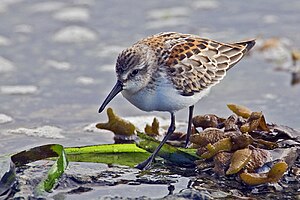Mountain sandpiper
| Mountain sandpiper | ||||||||
|---|---|---|---|---|---|---|---|---|

Mountain sandpiper in youth dress |
||||||||
| Systematics | ||||||||
|
||||||||
| Scientific name | ||||||||
| Calidris mauri | ||||||||
| ( Cabanis , 1857) |
The sandpiper ( Calidris mauri ) is a small wader belonging to the sandpiper genus . Mountain sandpipers are the rarest wanderers among the American sandpipers in Europe .
features
The sandpiper is 14 to 17 centimeters long. Just like sand sandpipers , they have very small membranes between their toes. The legs, beak, and eyes are dark. The beak is slightly longer than that of the other species in the genus, is thin and slightly bent downwards. The throat and underside of the trunk are white. The stripe above the eyes is wide and light. The ear covers behind the eyes are dark. The top of the head, the nape of the neck and the coat are darkly dashed lengthways. The large and medium arm covers and the arm wings are monochrome brown-gray with a diffuse, darker wedge mark.
In the splendid dress , the large ceilings at the edges are clearly rust-brown except for the back, with black triangular spots and white end hems clearly set off from the gray ceilings. The parting sides and the ear patches are also mostly rust-brown. The breast stripes are stronger and go from the breast in arrowheads of a similar shape to over the flanks to the sides of the under tail coverts. The belly is not drawn.
The simple dress is very similar to that of the sand beach walker. However, the entire breast is finely dashed. The rust brown of the upper side of the wing and the back is replaced by a solid gray.
In the youth dress , only the innermost edge ceilings on the border to the umbrella ceilings are lined with a strong reddish brown, which also spreads on the back to the tail. All other coverts and the arm wings have white ends. The breasts are missing, but the sides of the mantle are thin and sharp. The over-eye stripe is wide and light.
In flight, the sandpiper calls out a short, bright “tjit”.
Habitat, Distribution, Reproduction and Food
The breeding area of the sandpiper includes the tundra in Eastern Siberia and Alaska . Its wintering area is on the Atlantic and Pacific coasts of North and South America . The sandpiper is one of the most numerous shorebirds in North America.
It is a ground breeder , usually a hollow is dug under vegetation. Similar to sand sandpipers, the male scratches several ground hollows and the female selects the one that will be used as a nesting site. The clutch comprises an average of four eggs. Both parent birds are involved in the breeding business. The young birds are looked after by both parent birds. Often the female leaves the male and the young birds before they can fledge.
The sandpiper's diet consists of insects , small crustaceans and mussels .
swell
literature
- Jonathan Alderfer (Ed.): Complete Birds of North America , National Geographic, Washington DC 2006, ISBN 0-7922-4175-4
- Svensson, L .; Grant, PJ; Mullarney, K .; Zetterström, D .: The new cosmos bird guide - all species of Europe, North Africa and the Middle East. Franckh-Kosmos Verlags-GmbH & Co., Stuttgart. 1999. ISBN 3-440-07720-9
Individual evidence
Web links
- Calidris mauri in the endangered Red List species the IUCN 2008. Posted by: BirdLife International, 2008. Accessed on 7 November, 2008.
